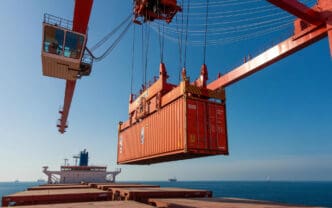Executive Summary
- The United States and China have agreed to a one-year pause on tit-for-tat port fees, de-escalating a significant trade irritant impacting an estimated $3.2 billion annually.
- The Section 301 penalties, initiated by the Trump administration to challenge China’s maritime industry, have been put on hold by the U.S., with China also suspending its countermeasures on U.S.-linked ships.
- While the pause offers immediate financial relief to the shipping industry, uncertainty persists regarding other potential U.S. penalties and the broader trade imbalances, despite China continuing to dominate global shipbuilding orders.
The Story So Far
- The agreement to pause tit-for-tat port fees between the U.S. and China addresses a significant irritant that arose from the Trump administration’s earlier imposition of Section 301 penalties. These penalties were initiated to challenge China’s dominance in the global maritime industry and bolster U.S. shipbuilding, following a U.S. probe that concluded China’s sector grip was driven by unfair practices, leading to substantial costs for ship operators and disrupting vessel schedules.
Why This Matters
- The one-year pause on tit-for-tat port fees between the U.S. and China offers immediate financial relief to the shipping industry, potentially tempering rising freight costs for consumers, and de-escalates a significant irritant in their broader trade dispute. However, this temporary agreement, reached by President Donald Trump and President Xi Jinping, leaves broader trade tensions and industry uncertainty unresolved, as fundamental issues surrounding global maritime competition are expected to remain subjects of ongoing negotiation.
Who Thinks What?
- President Donald Trump and the U.S. administration agreed to a one-year pause on Section 301 penalties on Chinese-built vessels, viewing it as a de-escalation move after initial tariffs aimed to challenge China’s maritime dominance, with Treasury Secretary Scott Bessent suggesting the threat of tariffs had already impacted demand for China-built ships.
- China’s Ministry of Commerce stated that China would suspend its countermeasures and fees on U.S.-linked ships, reciprocating the U.S. decision to pause Section 301 penalties concerning China’s maritime, logistics, and shipbuilding sectors.
- The shipping industry, including operators like High-Trend International Group, welcomed the suspension of fees, citing “immediate, material benefits” and the removal of a “long-standing cost and policy overhang,” though many, like Simon Heaney of Drewry, expressed frustration over continued uncertainty and hoped for “some permanency” in the agreement.
The United States and China have agreed to a one-year pause on tit-for-tat port fees impacting each other’s ships, a move aimed at de-escalating a significant irritant in their broader trade dispute. The agreement, reached by President Donald Trump and Chinese President Xi Jinping on Thursday, October 30, 2025, on the sidelines of the Asia-Pacific Economic Cooperation (APEC) summit in Busan, South Korea, provides a reprieve on an estimated $3.2 billion annually in fees for large Chinese-built vessels entering U.S. ports.
Easing Trade Tensions
The fees, which had escalated into a major point of contention, were initiated by the Trump administration earlier this year. These Section 301 penalties were designed to challenge China’s dominance in the global maritime industry and bolster U.S. shipbuilding, following a U.S. probe that concluded China’s grip on the sector was driven by unfair practices.
U.S. Treasury Secretary Scott Bessent confirmed on Fox Business Network that the Section 301 action had been put on hold. China’s Ministry of Commerce stated that the suspension applies to Section 301 penalties concerning China’s maritime, logistics, and shipbuilding sectors, adding that China would also suspend its countermeasures and fees on U.S.-linked ships.
Industry Impact and Uncertainty
The imposition of these fees had reportedly cost ship operators, including China-owned COSCO and U.S.-based Matson, millions of dollars, disrupting vessel schedules and driving up shipping expenses for consumers. Singapore-based ocean transportation provider High-Trend International Group welcomed the suspension, noting it offered “immediate, material benefits” by removing a “long-standing cost and policy overhang.”
While maritime executives broadly welcomed the pause, many expressed frustration over the continued uncertainty. Simon Heaney, a senior manager of container research at Drewry, voiced hope for “some permanency” in the agreement to allow the shipping industry to focus on facilitating global commerce.
The U.S. Trade Representative’s office has not yet commented on whether the pause extends to other U.S. penalties, such as those on non-U.S. auto carriers built outside of China, or the 100% tariffs on port cranes made in China that were also part of the Section 301 penalties.
Global Shipbuilding Landscape
Treasury Secretary Bessent suggested that the mere threat of the Section 301 tariffs had already impacted demand for China-built ships, noting a “substantial diminution or decreases in their order books.” However, data from the Center for Strategic and International Studies (CSIS), analyzing S&P Global information, indicates that Chinese shipyards continue to dominate global orders, capturing 53% of all ship orders by tonnage during the first eight months of 2025.
Looking Ahead
The one-year pause represents a tactical truce in a complex trade relationship, offering immediate financial relief to the shipping industry and potentially tempering rising freight costs. Despite this temporary agreement, the broader issues surrounding global maritime competition and trade imbalances between the world’s two largest economies are expected to remain subjects of ongoing negotiation and scrutiny.








